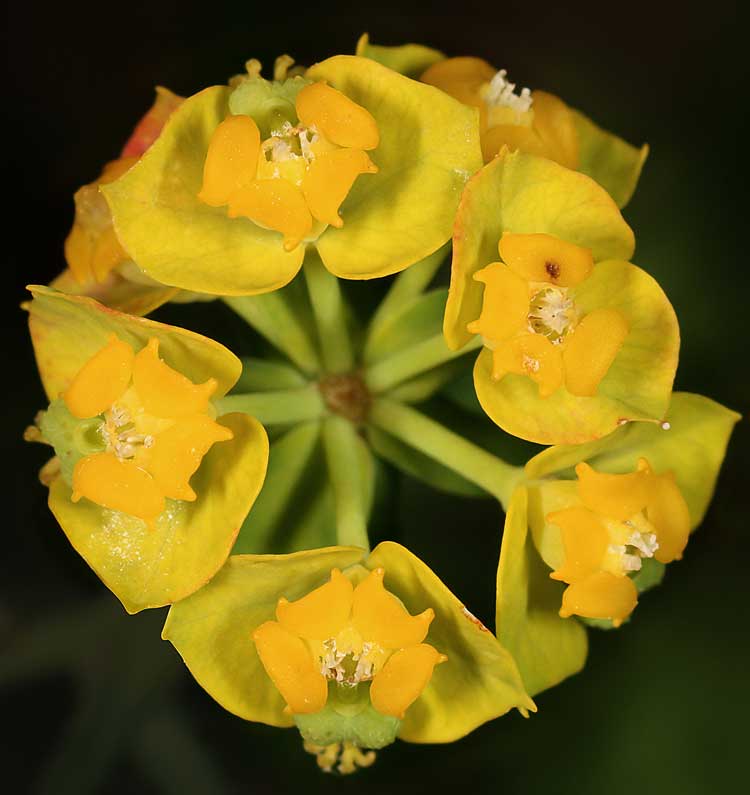
Euphorbia cyparissias (*)
lassification System: APG IV
Superregnum: Eukaryota
Regnum: Plantae
Cladus: Angiosperms
Cladus: Eudicots
Cladus: Core eudicots
Cladus: Rosids
Cladus: Eurosids I
Ordo: Malpighiales
Familia: Euphorbiaceae
Subfamilia: Euphorbioideae
Tribus: Euphorbieae
Subtribus: Euphorbiinae
Genus: Euphorbia
Subgenus: E. subg. Esula
Sectio: E. sect. Esula
Species: Euphorbia cyparissias
Name
Euphorbia cyparissias L., 1753
Synonyms
Homotypic
Tithymalus cyparissias (L.) Hill, Hort. Kew.: 172.4 (1768).
Esula cyparissias (L.) Haw., Syn. Pl. Succ.: 155 (1812).
Keraselma cyparissias (L.) Raf., Fl. Tellur. 4: 116 (1838).
Galarhoeus cyparissias (L.) Small ex Rydb., Fl. Plains N. Amer.: 520 (1932).
Heterotypic
Esula minor Garsault, Fig. Pl. Méd. 1: 264 (1764), opus utique oppr.
Tithymalus angustifolius Gilib., Fl. Lit. Inch. 2: 209 (1782), opus utique oppr.
Euphorbia punctata Krock., Fl. Siles. 2(1): 97 (1790), pro syn.
Euphorbia cyparissias var. esuloides DC. in J.B.A.M.de Lamarck & A.P.de Candolle, Fl. Franç., ed. 3, 5: 362 (1815).
Esula cupressina Gray, Nat. Arr. Brit. Pl. 2: 259 (1821 publ (1822)).
Euphorbia cyparissias var. degeneri Gaudin, Fl. Helv. 3: 278 (1828).
Euphorbia esuloides (DC.) Ten., Syll. Pl. Fl. Neapol.: 238 (1831).
Tithymalus cinerea Raf., Autik. Bot.: 91 (1840).
Euphorbia degenerata D.Dietr., Fl. March.: 227 (1841).
Euphorbia cyparissias var. major Boiss. in A.P.de Candolle, Prodr. 15(2): 160 (1862), nom. superfl.
Tithymalus acicularis Dulac, Fl. Hautes-Pyrénées: 156 (1867).
Euphorbia tyraica Klokov & Artemczuk, Fl. RSS Ucr. 7: 631 (1955).
Distribution
Native distribution areas:
References
Primary references
Linnaeus, C. 1753. Species Plantarum. Tomus I: 461. Reference page.
Links
Govaerts, R. et al. 2020. Euphorbia cyparissias in Kew Science Plants of the World online. The Board of Trustees of the Royal Botanic Gardens, Kew. Published online. Accessed: 2020 Jun 25. Reference page.
International Plant Names Index. 2020. Euphorbia cyparissias. Published online. Accessed: Jun 25 2020.
Govaerts, R. et al. 2020. Euphorbia cyparissias in Kew Science Plants of the World online. The Board of Trustees of the Royal Botanic Gardens, Kew. Published online. Accessed: 2020 Jun 25. Reference page.
Tropicos.org 2020. Euphorbia cyparissias. Missouri Botanical Garden. Published online. Accessed: 25 Jun 2020.
USDA, ARS, Germplasm Resources Information Network. Euphorbia cyparissias in the Germplasm Resources Information Network (GRIN), U.S. Department of Agriculture Agricultural Research Service. Accessed: 08-Apr-12.
Vernacular names
čeština: Pryšec chvojka
Cymraeg: Llaethlys cypreswydd
dansk: Cypresvortemælk
Deutsch: Zypressen-Wolfsmilch
dolnoserbski: Cypresowe wjelkowe mloko
Ελληνικά, Κυπριακά: Ευφορβία η κυπαρίσσια
English: Cypress Spurge
español: Euforbia ciprés
suomi: Tarhatyräkki
français: Euphorbe petit-cyprès
hornjoserbsce: Sucha mlóčeń
magyar: Farkas kutyatej
italiano: Euforbia cipressina
lietuvių: Siauralapė karpažolė
Nederlands: Cipreswolfsmelk
polski: Wilczomlecz sosnka
română: Alior
русский: Молочай кипарисовый
slovenčina: Mliečnik chvojkový
slovenščina: Cipresasti mleček
svenska: Vårtörel
українська: Молочай кипарисоподібний
walon: Laecea-d'-coloûte
中文(简体): 欧洲柏大戟
中文(繁體): 歐洲柏大戟
中文(臺灣): 歐洲柏大戟
中文: 歐洲柏大戟
Euphorbia cyparissias, the cypress spurge, is a species of plant in the genus Euphorbia. It is native to Europe and was introduced to North America in the 1860s as an ornamental plant.
Natural habitat types include dunes, pannes, coastal headlands and grasslands. In North America it is commonly found in the dry, gravelly soil of roadsides, pastures, and meadows. Cypress spurge thrives in open, disturbed areas.
leaves
Description
The plant ranges from 8 inches (20 cm) to 16 inches (40 cm) in height.[1] Its petal-like bracts are usually green-yellow, maturing to purple or red from May to August. The mature fruit explodes, spreading seeds up to 5 m (16 ft). The plant also reproduces through lateral root buds, which allow it to spread densely. It can be identified by its leaves, which are small and linear, measuring up to 4 cm (1.6 in) long by only 1 to 2 mm (1⁄32 to 3⁄32 in) wide.
Ecology
This plant is considered a noxious weed in many places, including Colorado in the United States. Like some other non-native plants, it invades the habitat of native species. It is known to be harmful to cattle and horses, but not sheep. It can be difficult to control. Biological pest control methods have been attempted, involving the release of several European insect species in North America. Certain flea beetles have been effective, but there are concerns about the release of non-native insects into the region.
Parasites of this species include Uromyces pisi-sativi, a fungus.
Anthrenus scrophulariae may frequently be found on this plant. This plant is attractive as an ornamental but its invasive nature makes it necessary to control its spread; its root spread is more invasive than its ability to self-seed.
Toxicity and uses
While the roots have sometimes been used as a purgative, it can be poisonous if taken in quantity, and animals can be poisoned by eating hay containing it. Contact with the sap can cause skin reactions.[2] WARNING: This plant has several irritants. The milky sap is a skin irritant that can cause burns/blisters in some individuals. Late season mature bracts have tiny hair like barbs. Once they are in your skin can cause mild irritation that can last for years . If you work with this plant use gloves and long sleeves. When you work this plant do not touch your skin with gloves on.
References
Reader's Digest A-Z Encyclopedia of Garden Plants; Brickell, Cole, Zuk
Niering, William A.; Olmstead, Nancy C. (1985) [1979]. The Audubon Society Field Guide to North American Wildflowers, Eastern Region. Knopf. p. 514. ISBN 0-394-50432-1.
3) Morgan, PL Home Gardener, Adk. Mtns, NYS
Retrieved from "http://en.wikipedia.org/"
All text is available under the terms of the GNU Free Documentation License

